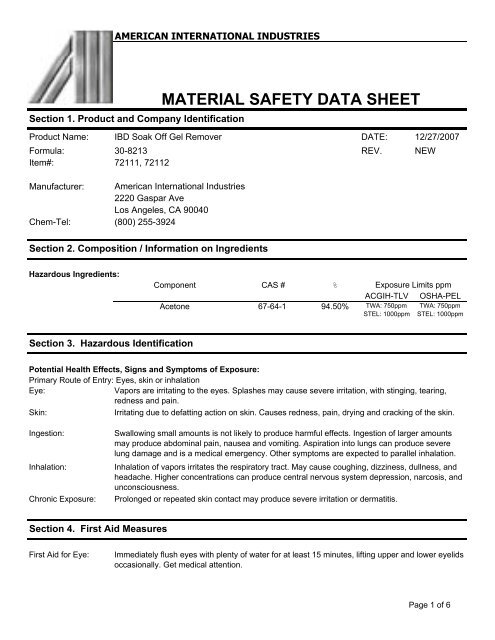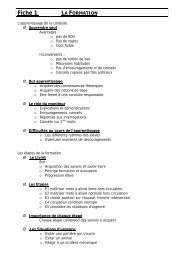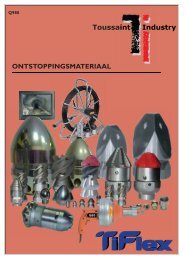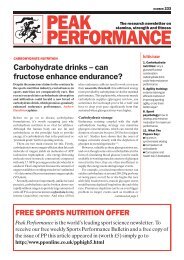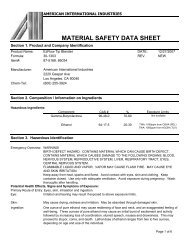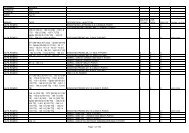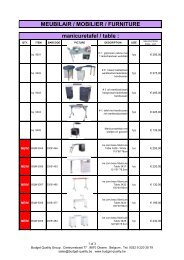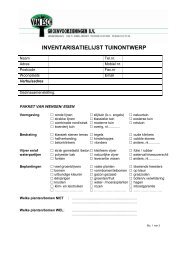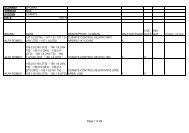30-8213 - IBD Soak Off Gel Remover - Proximedia
30-8213 - IBD Soak Off Gel Remover - Proximedia
30-8213 - IBD Soak Off Gel Remover - Proximedia
You also want an ePaper? Increase the reach of your titles
YUMPU automatically turns print PDFs into web optimized ePapers that Google loves.
AMERICAN INTERNATIONAL INDUSTRIES<br />
Section 1. Product and Company Identification<br />
Product Name: <strong>IBD</strong> <strong>Soak</strong> <strong>Off</strong> <strong>Gel</strong> <strong>Remover</strong><br />
DATE: 12/27/2007<br />
Formula: <strong>30</strong>-<strong>8213</strong><br />
REV. NEW<br />
Item#:<br />
72111, 72112<br />
Manufacturer: American International Industries<br />
2220 Gaspar Ave<br />
Los Angeles, CA 90040<br />
Chem-Tel: (800) 255-3924<br />
Section 2. Composition / Information on Ingredients<br />
Hazardous Ingredients:<br />
CAS # % Exposure Limits ppm<br />
ACGIH-TLV OSHA-PEL<br />
67-64-1 94.50% TWA: 750ppm<br />
STEL: 1000ppm<br />
TWA: 750ppm<br />
STEL: 1000ppm<br />
Potential Health Effects, Signs and Symptoms of Exposure:<br />
Primary Route of Entry: Eyes, skin or inhalation<br />
Eye:<br />
Vapors are irritating to the eyes. Splashes may cause severe irritation, with stinging, tearing,<br />
redness and pain.<br />
Skin:<br />
Irritating due to defatting action on skin. Causes redness, pain, drying and cracking of the skin.<br />
Ingestion:<br />
Inhalation:<br />
Chronic Exposure:<br />
Section 4. First Aid Measures<br />
First Aid for Eye:<br />
MATERIAL SAFETY DATA SHEET<br />
Component<br />
Acetone<br />
Section 3. Hazardous Identification<br />
Swallowing small amounts is not likely to produce harmful effects. Ingestion of larger amounts<br />
may produce abdominal pain, nausea and vomiting. Aspiration into lungs can produce severe<br />
lung damage and is a medical emergency. Other symptoms are expected to parallel inhalation.<br />
Inhalation of vapors irritates the respiratory tract. May cause coughing, dizziness, dullness, and<br />
headache. Higher concentrations can produce central nervous system depression, narcosis, and<br />
unconsciousness.<br />
Prolonged or repeated skin contact may produce severe irritation or dermatitis.<br />
Immediately flush eyes with plenty of water for at least 15 minutes, lifting upper and lower eyelids<br />
occasionally. Get medical attention.<br />
Page 1 of 6
First Aid for Skin:<br />
First Aid for Inhalation:<br />
First Aid for Ingestion:<br />
Section 5. Fire Fighting Measures<br />
AMERICAN INTERNATIONAL INDUSTRIES<br />
MATERIAL SAFETY DATA SHEET<br />
Flash Point (°F/°C): -0.40°F / -18.0°C (Tag Closed Cup)- Based on Flashpoint of Acetone.<br />
Flammable Limit LEL: 2.5<br />
(vol%):<br />
UEL: 12.8<br />
Extremely Flammable Liquid and Vapor!<br />
Auto-ignition Temp. 869°F / 465°C<br />
Extinguisher Media:<br />
Fire Fighting<br />
Procedures:<br />
Unusual Fire and<br />
Explosion Hazards:<br />
Section 6. Accidental Release Measures<br />
Spill or Release<br />
Procedures:<br />
Section 7. Handling and Storage<br />
Immediately flush skin with plenty of water for at least 15 minutes. Remove contaminated<br />
clothing and shoes. Get medical attention. Wash clothing before reuse. Thoroughly clean shoes<br />
before reuse.<br />
Remove to fresh air. If not breathing, give artificial respiration. If breathing is difficult, give<br />
oxygen. Get medical attention.<br />
Aspiration hazard. If swallowed, vomiting may occur spontaneously, but DO NOT INDUCE. If<br />
vomiting occurs, keep head below hips to prevent aspiration into lungs. Never give anything by<br />
mouth to an unconscious person. Call a physician immediately.<br />
Dry chemical, alcohol foam or carbon dioxide. Water may be ineffective. Water spray may be<br />
used to keep fire exposed containers cool, dilute spills to nonflammable mixtures, protect<br />
personnel attempting to stop leak and disperse vapors.<br />
Fire should be fought from a safe distance. Firefighters should wear full face, self-contained<br />
breathing apparatus and full protective clothing.<br />
Closed containers exposed to excessive heat may rupture. Do not crush or puncture containers.<br />
Ventilate area of leak or spill. Remove all sources of ignition. Wear appropriate personal protective<br />
equipment. Isolate hazard area. Keep unnecessary and unprotected personnel from entering. Contain<br />
and recover liquid when possible. Use non-sparking tools and equipment. Collect liquid in an appropriate<br />
container or absorb with an inert material (e. g., vermiculite, dry sand, earth), and place in a chemical<br />
waste container. Do not use combustible materials, such as saw dust. Do not flush to sewer! If a leak or<br />
spill has not ignited, use water spray to disperse the vapors, to protect personnel attempting to stop lea<br />
and to flush spills away from exposures. US Regulations (CERCLA) require reporting spills and releases<br />
to soil, water and air in excess of reportable quantities. The toll free number<br />
for the US Coast Guard National Response Center is (800) 424-8802.<br />
Page 2 of 6
Handling & Storing:<br />
AMERICAN INTERNATIONAL INDUSTRIES<br />
MATERIAL SAFETY DATA SHEET<br />
Respiratory Protections (Specific Type):<br />
Not normally needed under proper conditions of use and storage.<br />
Ventilation to be Used:<br />
Local and Mechanical recommend<br />
Other Protective Clothing and Equipment:<br />
Skin: Wear impervious protective clothing, including boots, gloves, lab coat, apron or coveralls, as<br />
appropriate, to prevent skin contact.<br />
Eye: Use chemical safety goggles and/or a full face shield where splashing is possible. Maintain eye<br />
wash fountain and quick-drench facilities in work area.<br />
Hygienic Work Practices:<br />
Wash hand thoroughly after using this product and before eating, drinking, or smoking.<br />
Appearance @ 25°C: Clear liquid Viscosity (RVT): Not applicable<br />
Odor @ 25°C: Characteristic Vapor Pressure: Not available.<br />
pH Not applicable Vapor Density: Not available.<br />
Specific Gravity: 0.787 Evaporation Rate: Not available.<br />
Ignition: Not applicable Refractive Index: Not available.<br />
Melting Point: Not applicable<br />
Boiling Point: Not available.<br />
Solubility in Water Miscible<br />
Stability: Stable under ordinary conditions of use and storage.<br />
Incompatibility (Materials to Avoid):<br />
Protect against physical damage. Store in a cool, dry well-ventilated location, away from any area<br />
where the fire hazard may be acute. Outside or detached storage is preferred. Separate from<br />
incompatibles. Containers should be bonded and grounded for transfers to avoid static sparks.<br />
Storage and use areas should be No Smoking areas. Use non-sparking type tools and equipment,<br />
including explosion proof ventilation. Containers of this material may be hazardous when empty<br />
since they retain product residues (vapors, liquid); observe all warnings and precautions listed for<br />
the product.<br />
Section 8. Exposure Controls / Personal Protective Equipment<br />
Section 9. Physical and Chemical Properties<br />
Section 10. Stability and Reactivity<br />
Hazardous Decomposition Products:<br />
Carbon dioxide and carbon monoxide may form when heated to decomposition.<br />
Page 3 of 6
Hazardous Polymerization:<br />
Will not occur<br />
Conditions to Avoid:<br />
ACETONE:<br />
Acute Oral Toxicity:<br />
Acute Dermal Toxicity: No data available.<br />
Acute Inhalation<br />
Toxicity:<br />
Skin Irritation:<br />
AMERICAN INTERNATIONAL INDUSTRIES<br />
No data available.<br />
Eye Irritation: Irritating to eyes.<br />
Sensitisation: Not expected to be a skin sensitiser.<br />
Repeated Dose<br />
Toxicity:<br />
Low systemic toxicity on repeated exposure.<br />
Mutagenicity: Not mutagenic.<br />
Carcinogenicity: Not expected to be carcinogenic.<br />
Reproductive and Not expected to impair fertility<br />
Developmental<br />
Toxicity:<br />
Section 12. Ecological Information<br />
ACETONE:<br />
Acute Toxicity<br />
Fish: No data available.<br />
Aquatic Invertebrates: No data available.<br />
Algae: No data available.<br />
Micro organisms: No data available.<br />
Mobility:<br />
Persistence /<br />
degradability:<br />
MATERIAL SAFETY DATA SHEET<br />
Concentrated nitric and sulfuric acid mixtures, oxidizing materials, chloroform, alkalis, chlorine<br />
compounds, acids, potassium t-butoxide.<br />
Heat, flames, ignition sources and incompatibles.<br />
Section 11. Toxicological Information<br />
No data available.<br />
Not irritating to skin. Prolonged/repeated contact may cause defatting of the skin which can lead<br />
to dermatitis.<br />
If product enters soil, it will be mobile and may contaminate groundwater. Dissolves in water.<br />
Readily biodegradable.<br />
Page 4 of 6
Bioaccumulation:<br />
AMERICAN INTERNATIONAL INDUSTRIES<br />
Section 13. Disposable Considerations<br />
MATERIAL SAFETY DATA SHEET<br />
Whatever cannot be saved for recovery or recycling should be handled as hazardous waste and sent to a RCRA<br />
approved incinerator or disposed in a RCRA approved waste facility. Processing, use or contamination of this product<br />
may change the waste management options. State and local disposal regulations may differ from federal disposal<br />
regulations. Dispose of container and unused contents in accordance with federal, state and local requirements.<br />
<br />
Proper Shipping Name (49CFR 172.101): Flammable Liquids, n.o.s. (Acetone)<br />
Hazard Class: 3<br />
UN/NA: UN1993<br />
Packing Group: II<br />
ACETONE:<br />
EC Label Name: Acetone<br />
EC Labe/EC Number: 200-662-2<br />
EC Classification: Highly flammable. Irritant.<br />
EC Annex I Number 606-001-00-8<br />
EC Symbols: F Highly flammable.<br />
Xi Irritant.<br />
EC Risk Phrases: R11 Highly flammable.<br />
R36 Irritating to eyes<br />
R66 Repeated exposure may cause skin dryness or cracking.<br />
R67 Vapours may cause drowsiness and dizziness.<br />
EZ Safety Phrases: S9 Keep container in a well-ventilated place.<br />
S16 Keep away from sources of ignition - No smoking<br />
S26 In case of contact with eyes, rinse immediately with plenty of water and seek medical advice.<br />
AICS Listed.<br />
DSL Listed.<br />
INV (CN) Listed.<br />
ENCS (JP) Listed.<br />
TSCA Listed.<br />
EINECS Listed.<br />
KECI (KR) Listed.<br />
Not expected to bioaccumulate significantly.<br />
Section 14. Transportation Information<br />
Section 15. Regulatory Information<br />
Page 5 of 6
PICCS (PH Listed.<br />
Section 16. Other Information<br />
Additional information available upon request.<br />
AMERICAN INTERNATIONAL INDUSTRIES<br />
MATERIAL SAFETY DATA SHEET<br />
Page 6 of 6


